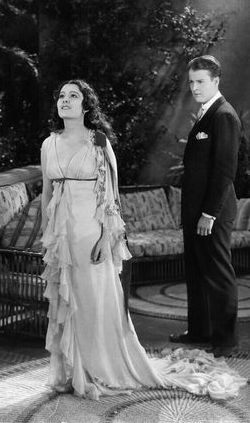
It’s the same story as Dracula, with Conde Drácula (Carlos Villarías) travelling to London with Renfield (Pablo Álvarez Rubio) where he encounters Eva Seward (Lupita Tovar) and Lucía (Carmen Guerrero), and faces off against Doctor Seward (José Soriano Viosca), Juan Harker (Barry Norton), and Dr. Van Helsing (Eduardo Arozamena).
In 1931 there was a major market for Spanish language films, dubbing was difficult, and subtitles weren’t going to cut it, so the easiest solution was to make a second version of a film. The day shift would finish up their work on the English language movie, and then the night shift would come in, using the same sets, scripts, and blocking, and do it all again.
So they shot Drácula. Tod Browning, Bela Lugosi, and the English language cast would head home and George Melford, Carlos Villarías, and the Spanish-speakers would get to work. The cast was a mix of Mexicans, South Americans and Spaniards. Melford’s assignment is a little harder to figure as he didn’t speak or understand Spanish. I can’t help but speculate that Melford’s interpreter, Enrique Tovar Ávalos, who was also a director, might have had a hand on the wheel. Whatever the reasoning, this was Melford’s forth Spanish duplicate job.
There is a fundamental difference in the purpose of Drácula compared to Dracula, and that can be seen both practically and artistically. Drácula is a sound picture. That is its reason for existence—if sound wasn’t primary they’d have just stuck intertitles on Browning’s. Talking is what matters. And talkies as an art form was different than silent films. They are, by nature, one step closer to reality. And while the image still rules, it’s no longer the only thing; sound matters. Dracula was shot to work as a talkie, but also as a silent picture. Theaters that didn’t yet have sound equipment would get a version of Dracula without sound, and with Intertitles. So, less speaking was a plus, and anything that was spoken needed to get right to the point. Drácula was only going to theaters equipped for sound located in Spanish-speaking communities, so it could allow itself to be more casual with conversations. Artistically, Dracula was interested in burning specific images into your brain, while Drácula was more directed toward the over all flow of the picture.
What hits me hardest when the film starts is how much more dynamic Drácula is. Browning & Freund’s camera work is static in Dracula. The shot will swing a bit, rotate, and shift, but rarely more. Melford takes it for a ride. We’re introduced to Conde Drácula, not with a tracking shot as he walks, but with the camera sweeping in from on-high, and then climbing up the stairs. Melford and his crew would watch the dailies from Browning’s work and try to improve upon them, adding new movements. Technically it’s more advanced, but is it better? Well, they are trying for different things, but keeping that in mind, I find Browning’s shots to be more attractive, more evocative. The rollercoaster intro of Villarías is not as eerie Lugosi’s slow steps. Except for the final shot of Juan and Eva walking up the stairs and Van Helsing standing over Renfield’s body (a very static shot), the imagery in Drácula isn’t as powerful as that in Dracula.
Drácula started with the same shooting script (translated) as Drácula, though they didn’t end up that way. Between Browning and boss Carl Laemmle, Dracula got substantially cut while this version kept the entire script. That helps with pacing and continuity. There are abrupt jumps in Dracula, along with dropped plot threads (what happens to Lucy?). Those aren’t problems with Drácula. The beginning, with Renfield on the stagecoach, flows much better giving us not only a more complete introduction to the character and the world, but to the film. We’re given a few extra minutes to adjust. And much of act 3 works better. It isn’t all an improvement. Sometimes the additional material dilutes the impact of a moment. Certainly both second act scenes of Renfield being questioned could be trimmed (as they are in Dracula), but on the whole, the editing is superior.
After editing, Drácula‘s major improvement is in relaxing the prudish nature of American films. The US was more uptight than Mexico, giving us buttoned up women in Dracula. Keeping in mind that vampirism is a metaphor for sex, those tight collars were out of place. Drácula shows a bit of cleavage, with a matching lascivious twinkle in Eva’s eye. Everyone is always so proper in Dracula. Eva and Lucía are more fun, and more alive then their counterparts. They become obsessed, instead of just depressed. I understand wanting to carry off Eva as she is in the third act, whereas I can’t figure why Dracula cares all that much about Mina.
Of course the big change is in the cast. Lupita Tovar aand Carmen Guerrero are a step up, though that may just be because they are allowed to display some sex appeal. Harker has been drab in every version of the story ever made, no matter who plays him, so his switch doesn’t matter. Arozamena makes for a slightly less powerful Van Helsing. He seems a little desperate—neither he nor Sloan are better or worse, just different. Rubio gives a substantially different performance from Dwight Frye as Renfield. He’s more manic and hysterical, and edges toward the comedic. He never feels creepy. Not that any of that matters. The change that counts is from Lugosi to Villarías and Villarias can’t compete. Lugosi is dangerous, powerful, and commanding. When he calls the women to him, I understand the force that pulls them. Villarias’s bug eyes and mugging makes him more akin to a flasher than the ultimate evil, which also makes him less sympathetic. He isn’t bad in the role. Of the many, many actors who have played Dracula, he’s in my top 10, but he can’t carry the film. He’s…fine. Lugosi is a legend.